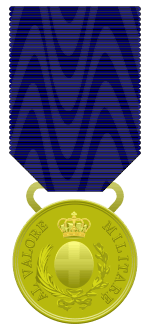Costantino Borsini

Costantino Borsini (April 7, 1906 in Milano – October 21, 1940 in Eritrean Red sea) was an Italian naval officer. He received the Gold Medal of Military Valor for his command of the Nullo destroyer in the Attack on Convoy BN 7 in October 1940.[1]
Biography
He was born in Milan in 1906. Borsini was a top student at the Naval Academy of Livorno from March 15, 1922 to November 15, 1926. There he received the appointment as a midshipman, taken before embarking on the battleship Giulio Cesare. Later he went to the battleship Andrea Doria and other Italian navy ships, until in July 1932 when he received a promotion to "Lieutenant".
In 1933 he joined the Marine Detachment in Tianjin (China). At his return to Italy he attended the course in Taranto for "Observation of Airplanes" and in 1935 he received his patent: successively he worked for one year as member of the "153rd Squadron Seaplanes".
Then he was moved on submarines and at the end of this experience, in 1937, Borsini assumed the role of "Officer 2nd" on the destroyer Nembo after which he was given command of the torpedo-boat Clio.
In January 1940 he embarked on the colonial ship Eritrea, which was located in the Eritrean Red Sea at Massawa, and in May of that year he achieved the promotion to "Lieutenant Commander" and was given command of the destroyer Francesco Nullo, operating in the Red Sea.
On October 21, in waters near the island Harmil, captain commander Borsini maintained a fierce battle with his ship against enemy cruisers and destroyers. In the battle the Nullo equipment was affected and lessened in its operational efficiency, but he arranged to drive his ship toward an Italian coastal battery so that their cannons could hit an enemy ship attacking him.
When his ship was hit and started to sink, he put in secure place the crew and successively decided to go down with his ship while at the command post. The attacking British destroyer Kimberley was hit by the Italian batteries and remained in repair until spring 1941.
Of the 120 members of the Nullo crew, only 106 survived and were rescued by sailors of the Harmil battery while 12 perished in combat and two (captain Borsini and his assistant Ciaravolo) voluntarily sank with the ship. The Italian Royal Navy emitted the next week an order discouraging this action, even because other two Italian navy commanders -CV Enrico Baroni of destroyer Espero and CC Lorenzo Bezzi of submarine Liuzzi- had chosen to do this extreme sacrifice in the few months of war since Italy declared war to the Allies in June 1940.[2]
Battle of Harmil Island [3]
After the first minutes of naval combat against the British convoy BN 7, the Italian cacciatorpediniere Nullo intended to attack again the convoy BN 7 before following the other Italian ship Pantera toward Massawa, but Nullo's rudder jammed for several minutes, and the two ships lost contact with each other. Nullo's captain Borsini understood that was going to be destroyed by the incoming British warships and decided to approach the Italian batteries on Harmil island, in the hope that they could hit the attacking enemy vessels.[4]
At 02:20 British light cruiser Leander spotted Nullo, and engaged at a range of 4600 yards. The ships dueled for around ten minutes. Leander scored several hits, damaging Nullo's gyrocompass and gunnery director. Nullo withdrew toward Harmil island and Leander pursued. Destroyer Kimberley joined the pursuit at 0300. At 0305 Leander turned back for the convoy.
At 05:40 on 21 October, Kimberley was off Harmil Island when her lookouts spotted the Nullo. Nullo spotted Kimberley around the same time, but the captain of the Nullo assumed that the approaching ship was the Sauro. Kimberley opened fire at 05:53, catching Nullo by surprise. Nullo returned fire four minutes later, and at 06:15 the four Italian 120 mm guns on Harmil Island joined the action.
At around 0625 Nullo was hit by two shells from Kimberley, one each in the forward and aft engine rooms. Nullo lost all power. Nullo's captain gave the order to abandon ship and steered the ship towards Harmil, attempting to run it aground. He decided to sink with his ship. Captain Costantino Borsini (and his attendant Ciaravolo [5] who decided to die with him) were awarded the Gold Medal by the Italian Navy, that later forbade this extreme sacrifice.
Kimberley fired two torpedoes at Nullo. The second of these, at 0635, tore Nullo in two. The Harmil battery then found the range and landed a shell on Kimberley's engine room, causing the ship to lose power. Kimberley fired at the shore battery while the crew frantically repaired the damage. Finally, Kimberley's power was restored, and the ship managed to get out of range of the Harmil battery before losing power again and later be towed to safety in Port Sudan.
Notes
- ↑ Italian Navy Gold Medal (with photo of captain Costantino Borsini)
- ↑ Nullo sinking and actual remains photos (in Italian)
- ↑ Battle of Harmil (in Italian) Archived March 4, 2016, at the Wayback Machine.
- ↑ Nullo history, with reference to captain Borsini sacrifice (in Italian)
- ↑ Gold Medal for Ciaravolo
Bibliography
- Giuseppe Vingiano. L'epopea del Cacciatorpediniere "Nullo", Editoriale di propaganda. Roma, 1942
- Vincenzo Meleca, " Tragedia alle Dahlak! L'affondamento del 'Francesco Nullo', http://www.ilcornodafrica.it/st-melecatragedia.pdf